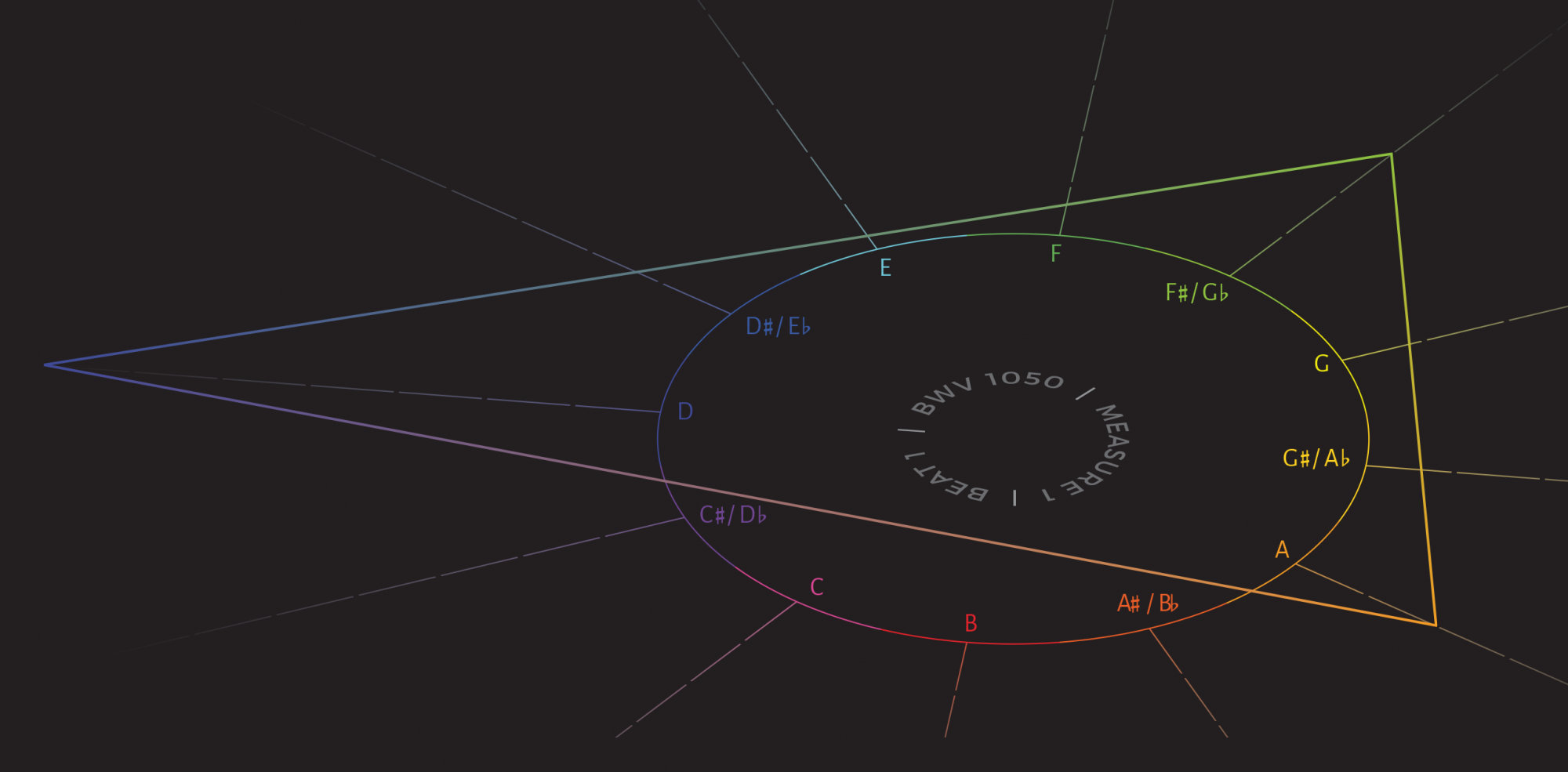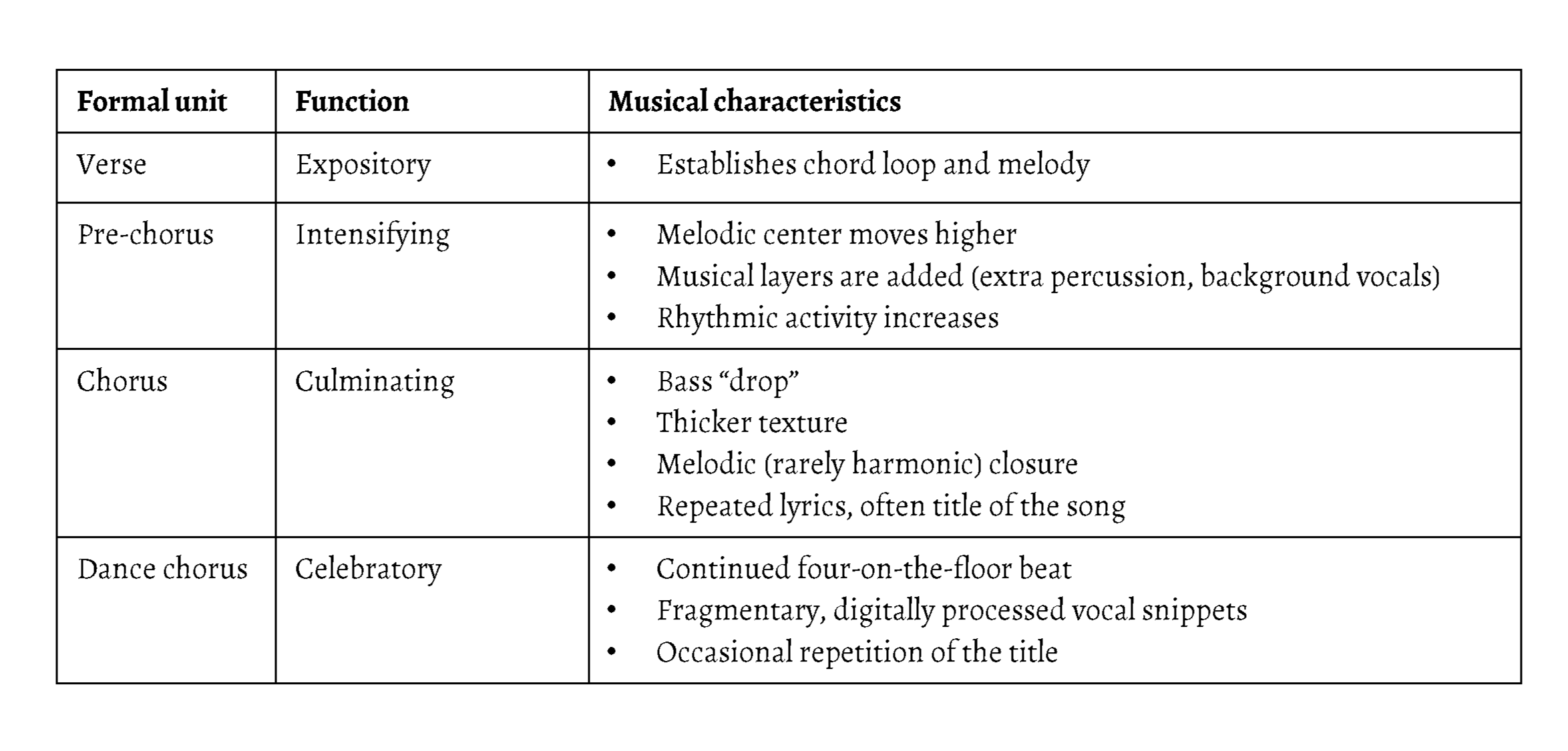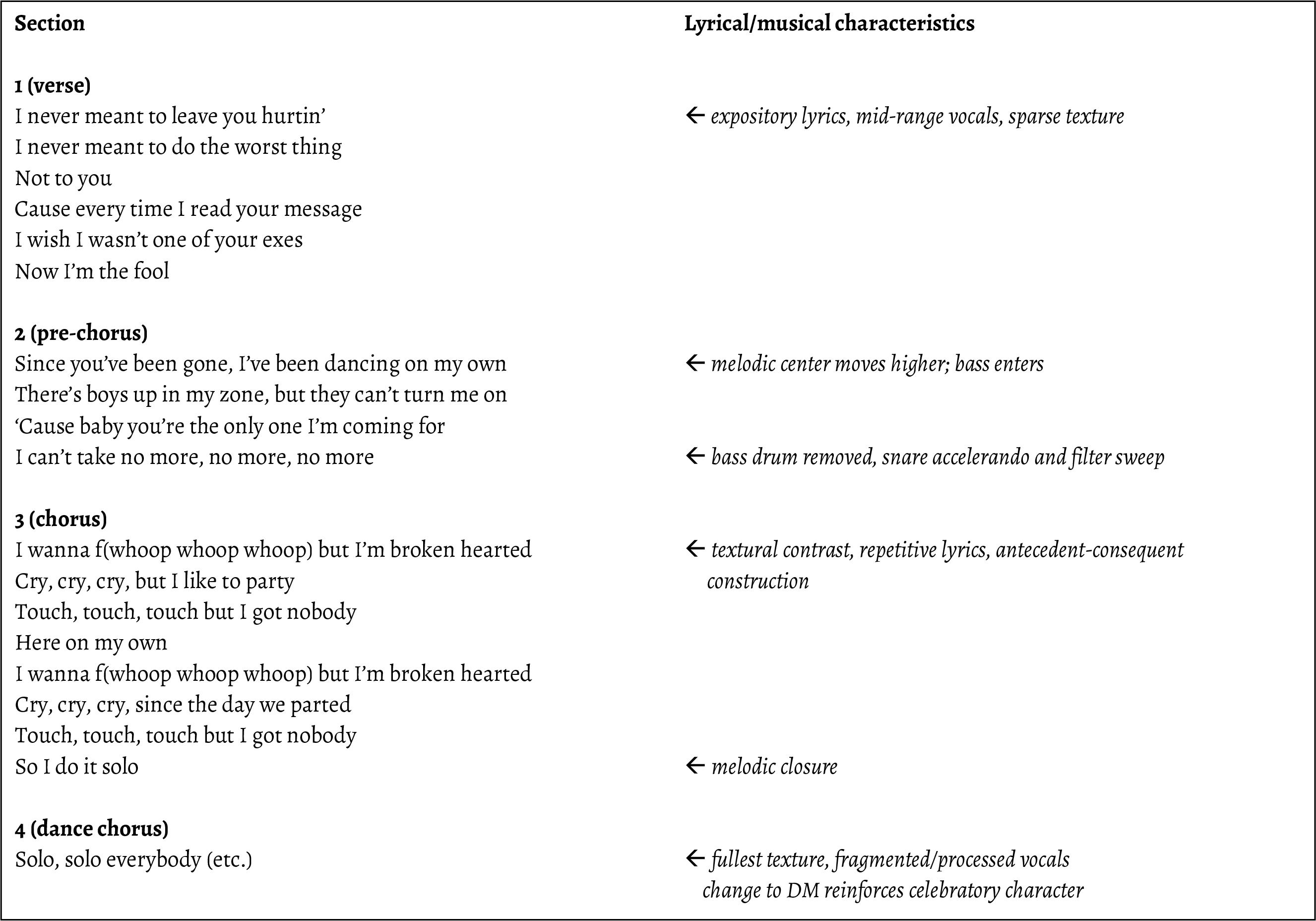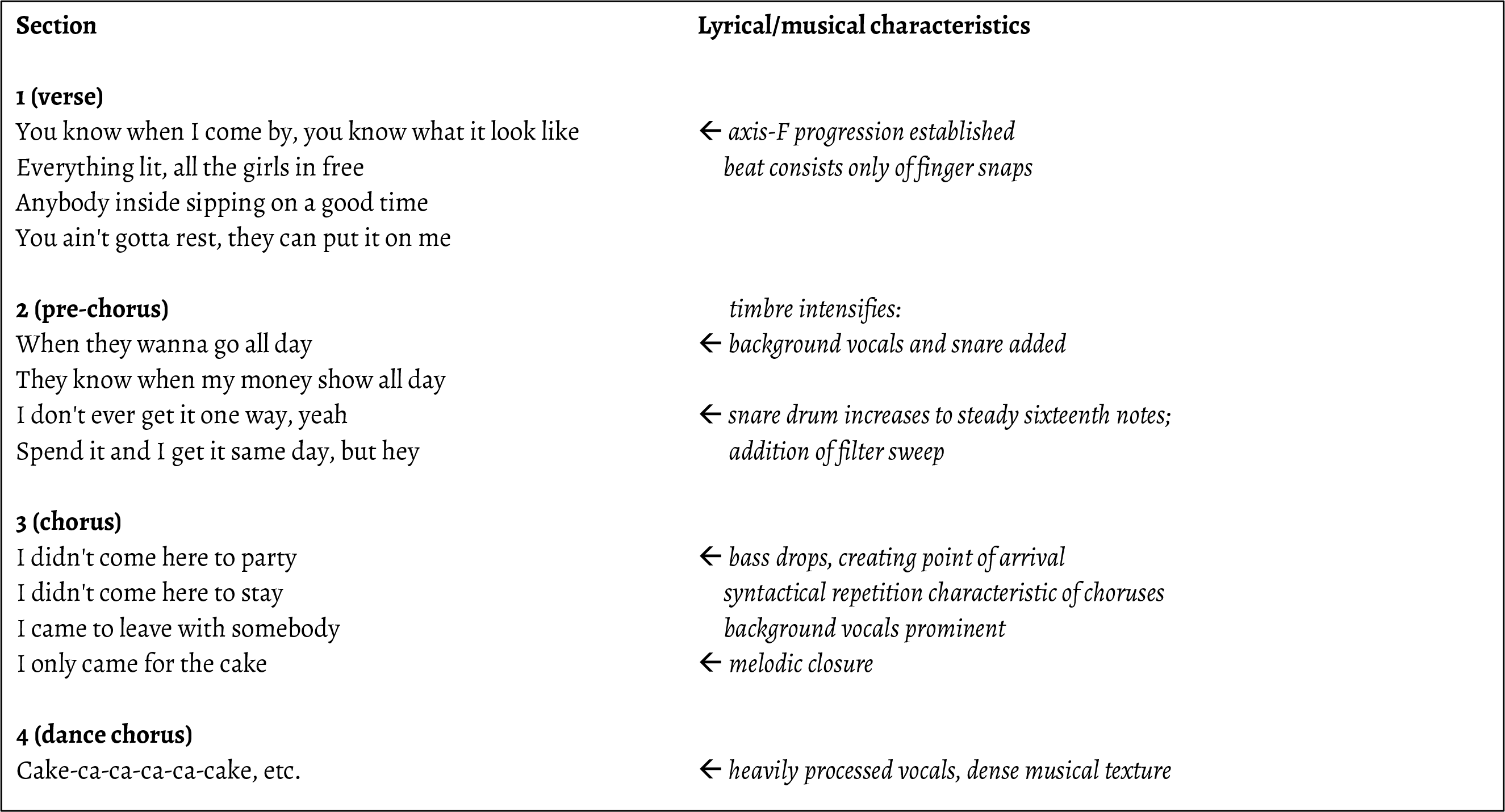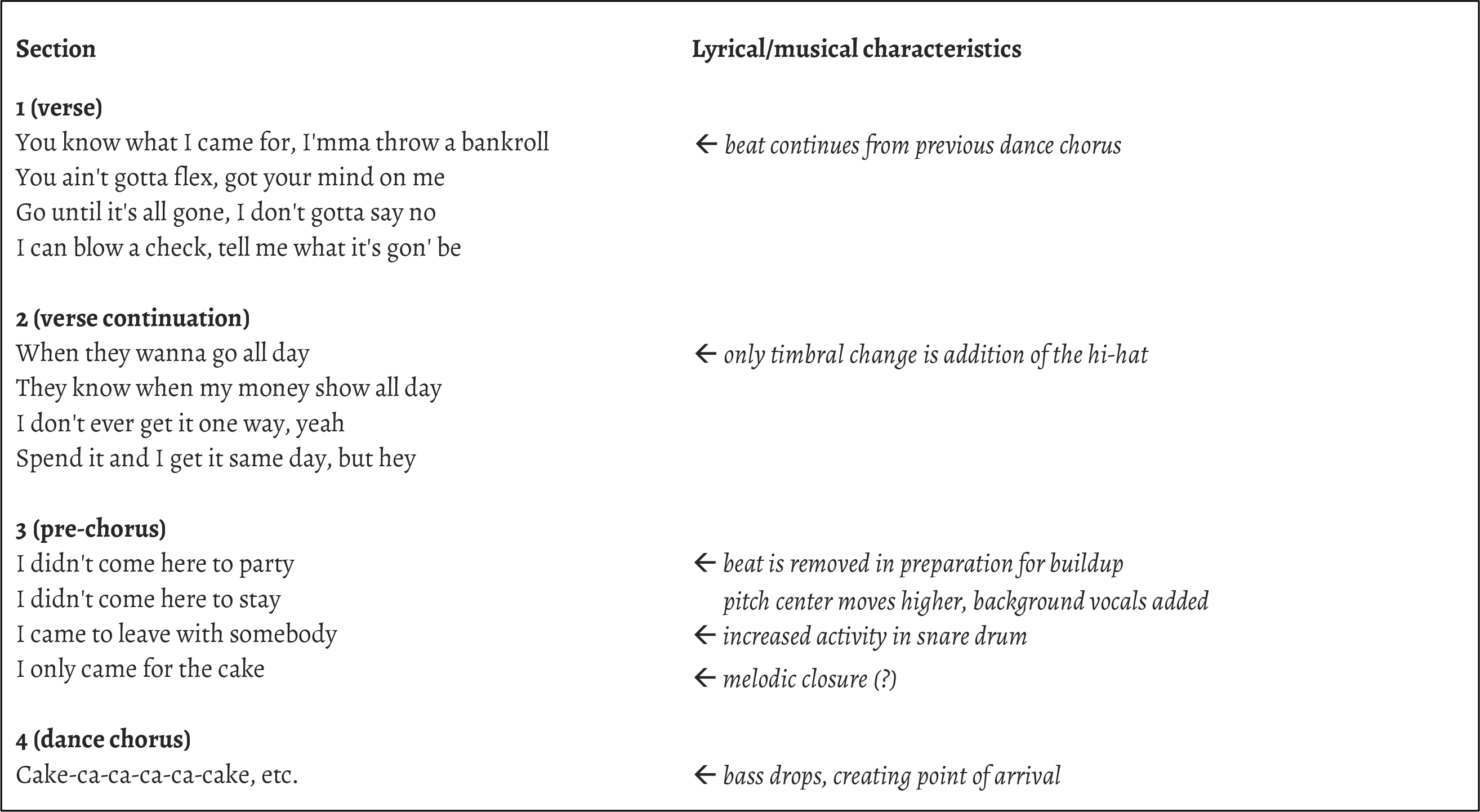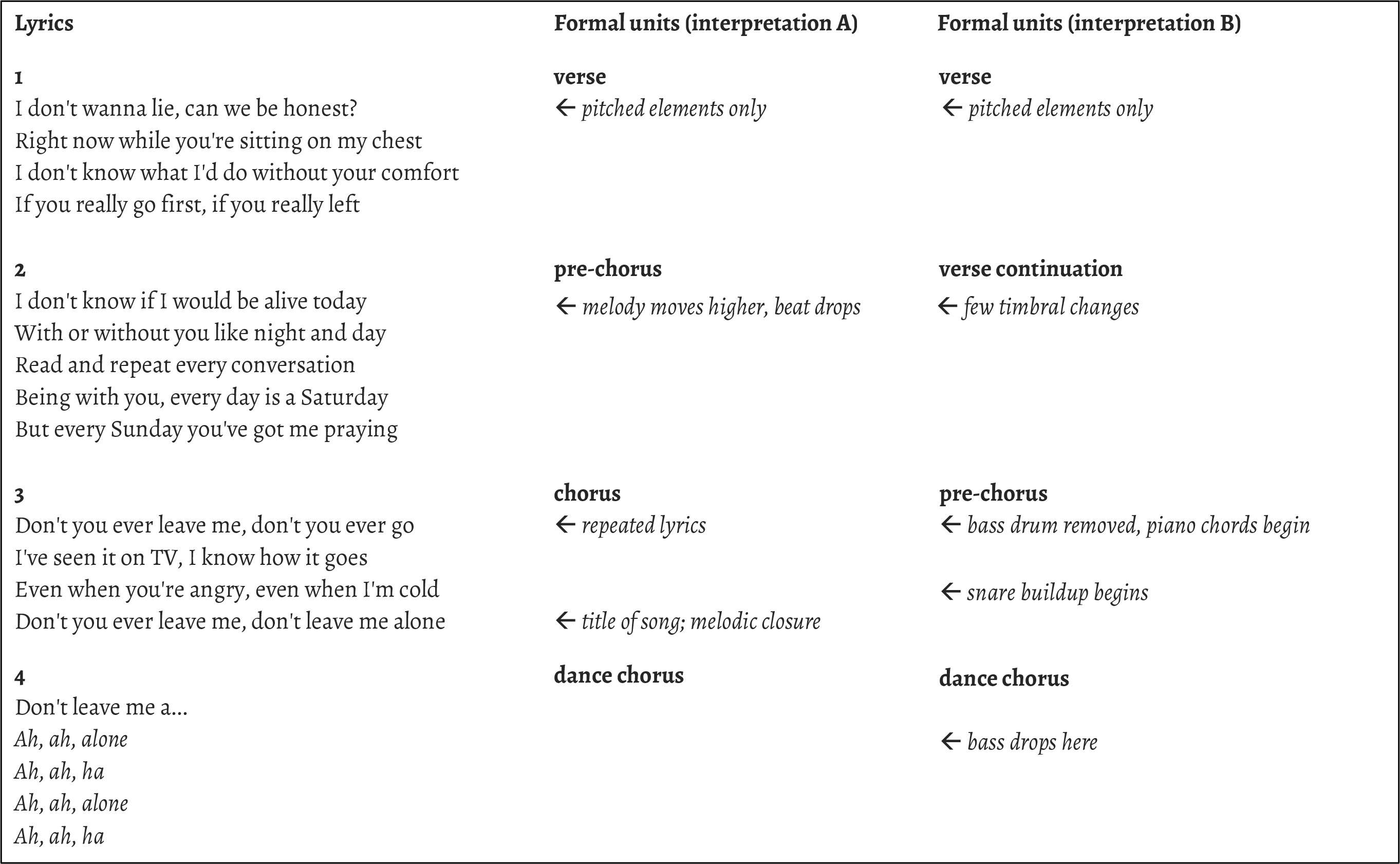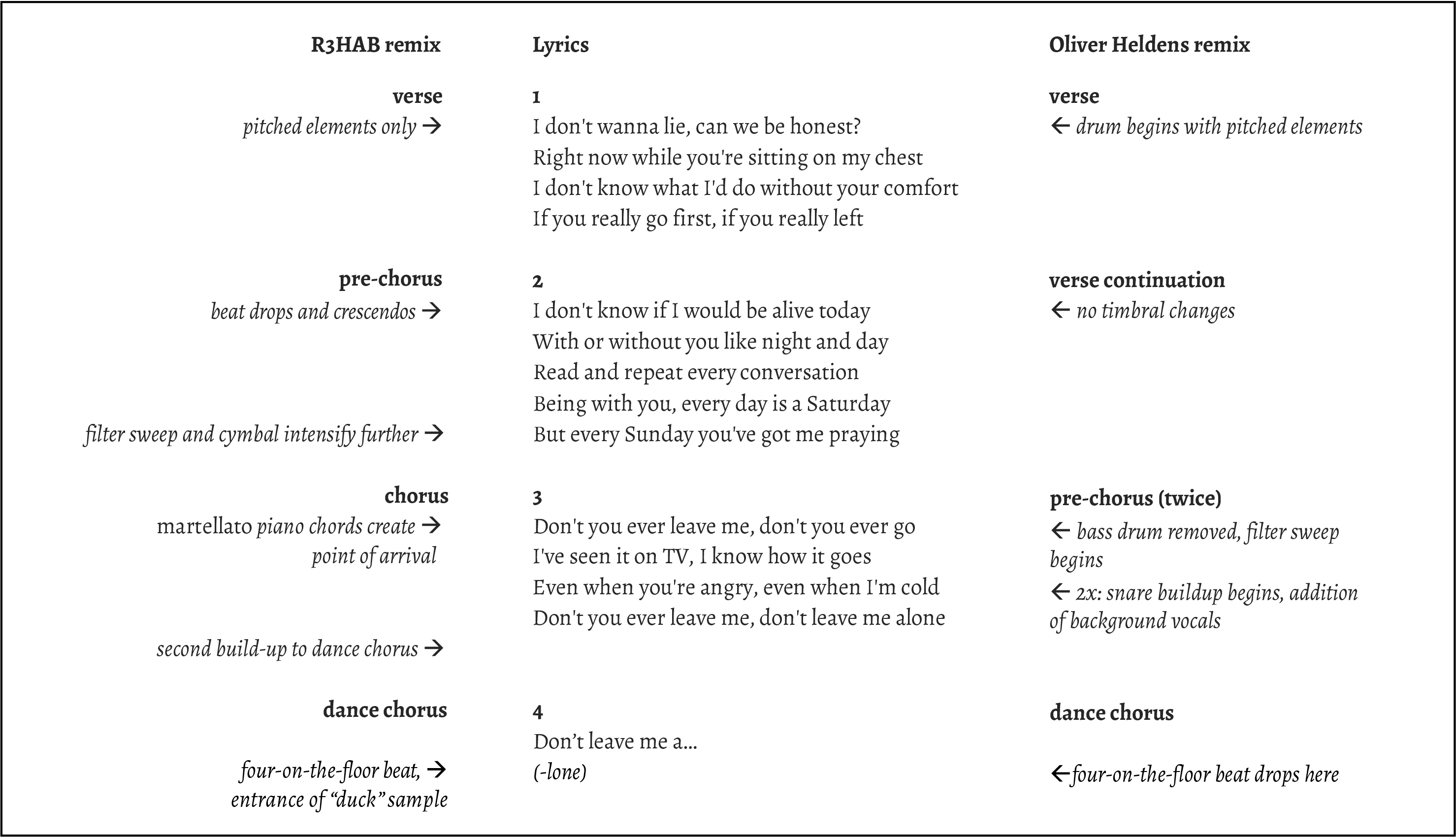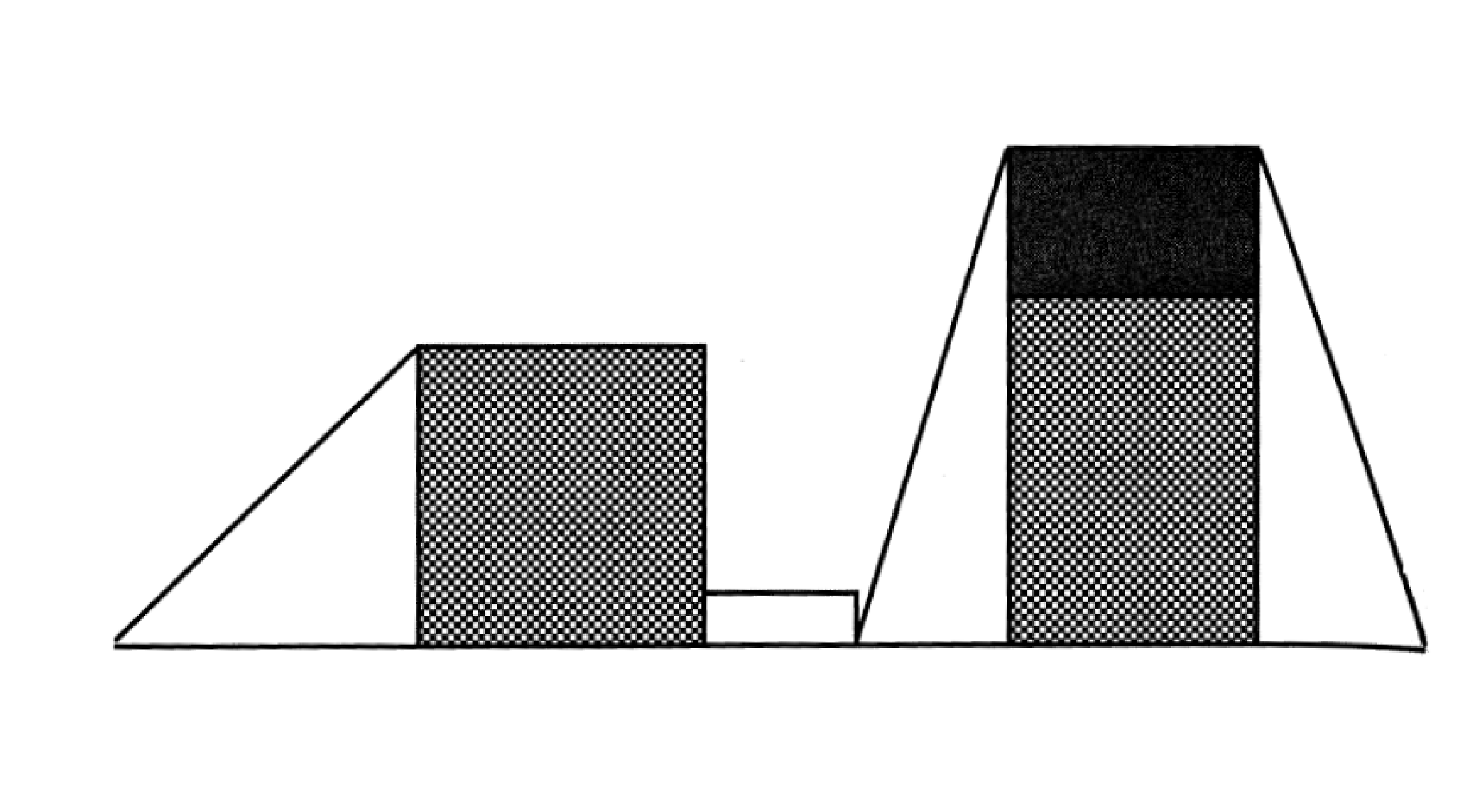Kyle Adams
Abstract
This article has two goals: first, to argue that formal units in recent, EDM-infused popular music are inherently unstable—that the same melodic/harmonic framework can fulfill different rhetorical functions depending on its timbral underpinnings; and second, to demonstrate the critical role played by texture in defining formal units. After reviewing the standard formal functions in a twenty-first-century pop song, I will present two case studies in formal instability. In the first, “Cake” by Flo Rida, the song’s two sections are made up of virtually identical subsections that nevertheless project different formal functions. In the second, “Don’t Leave Me Alone” by David Guetta, remixes of the song change the formal elements by adding and removing timbral layers. Finally, I argue that the instability presented in these songs is a result of a unique blend of pop music and EDM, and that it forms a crucial part of the listening experience.
View PDF
Keywords and phrases: form, verse-chorus unit, popular music, EDM, Flo Rida, David Guetta
Suggested Citation[F]orm in rock music involves a variety of musical domains . . . It is doubtful that any single parameter is wholly responsible for this feeling; our perception of form is presumably complex and multifaceted, something that inherently resists codification through simple definitions (de Clercq 2017b, 144).
[One] approach to analyzing sections is to begin from the perspective of individual functions rather than section identity (Biamonte 2019).
This article is best introduced by the two quotes above. In the first, Trevor de Clercq acknowledges that form in popular music is often less clear than it may seem and implies that the perception of formal units will often depend on which parameters are prioritized by a given listener. In the second, Nicole Biamonte proposes an organic approach to formal analysis, in which formal sections are not given a priori status but rather coalesce as a product of the various musical markers with which they are associated.
Beginning with quotations from other scholars both illustrates the practical way in which this article took shape and lays the groundwork for my approach. This brief essay will build on many ideas that are “in the air,” so to speak, to inform my own thoughts about form in a subset of post-millennial pop music (specifically, EDM [electronic dance music]-infused pop from the past decade).1 I have identified a curious feature of this music, in which the large formal units of a song typically contain four discrete sections but express only three musical functions. This creates a situation in which the function of a given section can be unclear, and I will show the ways in which producers exploit this lack of clarity to their musical advantage. The argument that I will put forth here is developed from de Clercq’s and Biamonte’s premises: namely, that formal units do not take on an identity unless a section has sufficient melodic, harmonic, lyrical, and (most critically) textural features to trigger an unambiguous classification. I will argue that the formal functions of a song’s sections are largely dependent on their sonic functions.2 Furthermore, a given span of music can project different formal functions from one part of a song to another, depending only on changes in texture, and does not require a consistent formal label throughout; that is, it does not have to “be” any one thing.
Although previous scholarship has foregrounded the crucial role played by melody and harmony in determining form,3 one of my main goals in the analyses to follow will be to highlight the equal—if not greater—role played by texture in post-millennial pop. I will present two case studies in which sections of a song exhibit enough inherent instability that subtle textural changes can alter their formal functions, despite the fact that the melody, harmony, and even lyrics may be identical. I use the term “instability” here rather than “ambiguity” because I feel it expresses best the way in which I perceive such formal units. “Ambiguity” is a general term that can refer to a variety of phenomena, including formal sections with unclear boundaries or formal units that combine elements of two or more sections. “Instability” captures well the sense that a formal unit is well-defined as a single section, but nevertheless teeters on the brink between different classifications. Moreover, although it is not the case with the examples in this article, the word “instability” (unlike “ambiguity”) leaves open the possibility that a song section might have more than two possible functions. In the case studies below, the boundaries of formal sections are uncontroversial, but a simple textural modification can tilt the balance in favor of one functional classification over another. Following Biamonte, de Clercq, and others, I will analyze song sections from the “bottom up,” argue that the interaction of multiple parameters can lead to multiple conflicting classifications, and ultimately demonstrate that the increased importance of texture in determining form reflects the influence of EDM on recent pop-music production. In my opinion, the formal instability described here does not represent a problem to be solved by the addition of new classificatory labels or methodological precepts; rather, it is a feature of the music to be celebrated.
1. The Parts of a Post-Millennial Pop Song
Many twenty-first-century popular song producers have adopted a standard formal structure: two rotations of a verse-chorus unit followed by a bridge and a final chorus. The term verse-chorus unit (hereafter VCU) was coined by David Temperley (2011) to refer to “some kind of large repeating section . . . [that] normally consists of a verse (with different lyrics on each occurrence) and chorus (with unchanging lyrics)” (par. 1.4). In this article, VCUs will also encompass the prechorus and dance chorus sections, which will be described in more detail below. The instability mentioned in the title of this article refers to the sections within each VCU; therefore, I will be focusing on comparisons between VCUs in a single song or among remixes. I will begin by describing the typical characteristics of the sections of a VCU, illustrating them with a normative case before moving on to the two studies of more atypical cases.
First, a bit of terminological untangling. Throughout this article, I will refer both to “sections” and to “formal units.” A section, as used here, denotes a functionally neutral part of a VCU, identifiable primarily by its length—typically four or eight measures—and by its order position.4 Thus, in my analytical case studies below, I label sections simply by number. Formal units such as verse and chorus, on the other hand, are tied to a set of specific, though not always identical, lyrical and musical characteristics as described in the following paragraphs. Though the formal units tend to proceed in a predictable order, this article shows that there is not always a one-to-one mapping between sections and their formal functions.
Figure 1 gives the rhetorical and musical characteristics of each formal unit within a VCU. The verse is no doubt the easiest to identify; as Temperley says, the verse has different lyrics on each occurrence, and in many post-millennial popular songs, it is the only formal unit to do so. I have listed its function as “expository,” since it lays the groundwork for the affective characteristics of both the lyrics and the music. After the verse, I have characterized the function of the prechorus as “intensifying,” following Summach 2011, the most thorough exploration to date of the prechorus. Summach notes that “[t]he prechorus raises the dynamic potential of verse-chorus form by imparting to it [a] teleological drive,” (par. 23). He lists many possible musical features that can create this drive, including “[c]hanges in groove, lyric phrasing, and the length of formal units, as well as dynamic level, register, instrumentation, timbre, harmonic progression, and harmonic rhythm,” (par. 3) and he points out that these devices will vary quite a bit among songs. In the music under consideration here, two intensifiers in particular seem to characterize prechoruses. The first is a heightened vocal register, with the melodic line either rising or moving to a higher center (for example, from $$\hat5$$ up to $$\hat1$$, as we will see below).5 The second feature is an increase in activity in the snare drum or equivalent synthesized percussion layer. Typically, this is performed as a diminution, from quarter notes to eighths to sixteenths and so on. Mark Butler notes that this is characteristic of buildup sections in EDM, a point to which I will return later on in this article.6
The buildup of momentum in the prechorus reaches its fulfillment in the chorus, the function of which I have listed as “culminating.” The chorus is one of the most familiar and recognizable sections of a popular song, and it has been amply described in scholarly and popular literature. Nevertheless, a reminder of its most salient features is worthwhile here: Walter Everett (2009) observes that “the chorus usually retains the same set of lyrics every time its music appears,” and that it often features a “thicker texture, and perhaps more dramatic harmonies, melodic shape, or rhythms than are characteristic of the verse” (145). Trevor de Clercq (2012) likewise notes that the chorus has a “focal” quality, pointing out its lyrical repetition, more generalized lyrical content, and its “increase in instrumental resources and general volume” (40).7 In current popular music, these textural elements are typically supplemented by a bass “drop” (i.e., entrance of the bass drum) that provides a satisfying resolution to the tension built up in the prechorus. In the rock music that Everett describes, the chorus is usually also characterized by harmonic closure, typically on I. This is often not the case in post-millennial pop music, which is frequently built around a series of functionally neutral or functionally ambiguous chord loops. However, the chorus in this repertoire does typically feature melodic closure on the tonic; in cases where such closure would conflict with the harmonies in the loop, producers will often mute the harmonic progression in the last line of the chorus.8
Many songs both within and outside of the repertoire under consideration here have a section following the chorus. Mark Spicer logically calls this the “postchorus,” describing it as a “brief, self-contained passage that can be heard as a departure from the chorus and yet does not serve merely as a transition to the next verse.”9 Spicer does not elaborate much on the characteristics of the postchorus, but I would highlight the fact that it is self-contained; it is heard as its own unit rather than as a transitional section. Alyssa Barna has identified a specialized type of postchorus (“post-” only in the sense that it follows the chorus) in music of the last decade or so. This section continues or increases the climactic energy of the chorus and is characterized by a dense musical texture and by fragmentary, digitally processed vocals.10 Barna has named this the “dance chorus,” a label she prefers to “postchorus” because it does not define the section by its relationship to any other part of the song, but rather acknowledges its independence.11
In her initial demonstration of the dance chorus, Barna defined several characteristics, which I will paraphrase here.12 Dance choruses are typically harmonically stable, employing the same progression as Chorus 1. They frequently create a sense of intensification through a higher volume, faster tempo, and a half-time pulse layer. They contain fewer lyrics, repeating most prominently the hook and/or the titular lyric. Finally, they employ memorable synthesized timbres unique to that section.
Barna stresses the fact that, although both the chorus and the dance chorus represent culminating points, they serve different expressive functions: “the simplified lyrics [of the dance chorus] discourage the audience from singing along; rather, the memorable hook and timbres associated with the dance chorus . . . promote movement and dance from the listener.” In Figure 1, I have characterized the function of the dance chorus as “celebratory,” in recognition of the fact that it prolongs the energy of the chorus through different musical means; as Peres says, it “maintain[s] or intensif[ies] the sonic energy” of the prior chorus (2016, 155). But it is worth emphasizing that, in many post-millennial popular songs, each VCU effectively has two climactic sections—a vocal climax (chorus) and an instrumental climax (dance chorus). Note that only three of the formal units have actual lyrics (the vocal snippets of the dance chorus notwithstanding). The vocals intensify during the prechorus and reach their emotional peak during the chorus, completing their expressive trajectory at the end of the third section of the song. The music, on the other hand, builds up over all four sections of the VCU, not reaching its emotional peak until the dance chorus; thus, the vocal and instrumental layers have separate climactic points. The existence of these dual climaxes—a vocal climax and an instrumental climax—and the necessity of a buildup to each one, lie at the heart of the instability to be discussed below.13
My approach to understanding this instability is most directly informed by the work of Trevor de Clercq,14 who has explored several different unusual formal scenarios in rock music; in fact, the case studies presented here are more or less an extension of de Clercq’s work on rock music of the twentieth century into pop music of the twenty-first. De Clercq (2012) describes two nonstandard formal types. The first is the “conversion,” which describes “shifts in our perception of section roles” (122) and refers to the ways in which sections of an organizational scheme like AABA can be mapped onto parts of a song, such as verses and choruses. More relevant here is de Clercq’s other category, the “blend,” which describes “those situations in which aspects of two (or more) section roles appear to exist within the same span of music” (213). He describes several different ways that blends can occur, including sections in which melody, harmony, and local positioning offer different formal readings for the same section. Crucially, de Clercq notes that “a robust understanding of how we perceive many musical passages necessarily requires us to recognize multiple roles acting at once” (213). Biamonte agrees, noting that “some instances of formal ambiguity result from a transfer of individual functions that are characteristic of one section type to other section types” (2019).
In the paragraphs to follow, I will present three analytical case studies. The first is a normative case, designed to lay out the prototypical formal functions in this repertoire. Then, the two analyses to follow will explore de Clercq’s possibility of multiple implied roles, extending his “blend” concept in two ways: in the first, the blend is not synchronic, but diachronic—a repeated formal section with the same melody, harmony, and lyrics takes on different formal roles in each presentation. In the second analysis, formal sections do not provide enough information for a definitive classification; instability arises because the addition or removal of timbres (and thus textural layers) causes a section to take on different functions among different remixes.
2. Normative case: “Solo”
Before exploring formal instability, it is worth examining a normative case. Example 1 gives the lyrics and formal sections for the first VCU of “Solo” (2018) by Clean Bandit, featuring Demi Lovato, a song that very clearly illustrates the functions of the verse, prechorus, chorus, and dance chorus. The left column gives the lyrics as well as the section and unit labels, and the right column lists the characteristics of each one.
The verse in “Solo” has the expository characteristics that one would expect. The lyrics introduce the protagonist’s emotional state, and the stability of the musical texture allows the lyrics a place of prominence. The vocal line hovers between $$\hat3$$ and $$\hat5$$ (D4 and F$$\sharp$$4, in the song’s key of B minor),15 in the middle both of the modal octave and of Lovato’s vocal range. The texture is sparse, consisting primarily of the drum rhythm and the staccato chords of the loop (Bm–AM–F$$\sharp$$m–GM), with occasional interjections of digitally processed vocals from Clean Bandit. Both the vocal line and the instrumental texture begin to intensify in the prechorus. The vocal line surges upward to $$\hat1$$ (B4), with the overall vocal range of the prechorus expanding to a ninth. The range of the overall musical texture similarly expands, with the addition of the bass line B–A–F$$\sharp$$–G supporting the harmonic template established in the verse’s loop. Finally, in the last line of the prechorus, the producers introduce intensifiers quite common in EDM: a filter sweep (the “whoosh” sound), and, in the last moments, a rapid snare accelerando, leading into the chorus.16
The chorus functions both as a point of arrival and as an expressive plateau, while still contrasting texturally with both the verse and prechorus. The musical layers empty out dramatically, leaving only the bass line and a pared-down drum texture of bass and snare with no hi-hat. The lyrics are repetitive, both at the level of the word (“cry, cry, cry”) and the line (the first three lines of the chorus are repeated verbatim). Melodically, too, the chorus is more stable than either of the previous sections: the melody has a period structure, with two parallel phrases closing on $$\hat3$$ in measure four and $$\hat1$$ in measure eight, the latter descent coinciding with the arrival on “solo,” the song’s title.
To the extent that one can speak of a “standard” dance chorus—given that the term is of such recent coinage—the dance chorus in “Solo” is a standard one: it is the most energetic, celebratory section of the song. The musical texture becomes much thicker, adding the synthesized strings (recall Barna’s statement that the dance chorus contains a timbre not previously heard in the song), and the “vocals,” as is typical, are pared down to a single, heavily processed repetition of the song’s title. The producers also substitute DM for F$$\sharp$$m in the loop, which results in a much more joyous, major-mode quality to the harmony. All of this has the effect of shifting listener focus from the lyrics (of which there are practically none) to the beat, and, as Barna would undoubtedly agree, motivating the listener to dance rather than to sing along.
In “Solo,” the four sections of the VCU are quite clear. The verse is expository and stable, in both lyrical and musical content, and the prechorus builds up tension in both parameters. These are followed by the vocal climax of the chorus and the musical climax of the dance chorus. But there are many other songs for which formal units are not so easy to pin down. For over two decades of scholarship on form in popular music, scholars have acknowledged situations of ambiguity, in which formal sections can be difficult to label, or in which a formal unit can have multiple labels depending on which parameters a given listener finds most salient. Ken Stephenson (2002) states that “in many [cases], changes in one or more areas work against a backdrop of stability in the other areas to create a subtler form. And in yet other cases, lack of alignment in the patterns of change of various areas makes for ambiguity” (122). And although most scholarship on form has focused on rock music, many of the same ideas pertain to twenty-first-century popular music as well (the differences will be discussed in the concluding section of this article). The case studies to follow will demonstrate two scenarios from recent popular music in which a section can take on different formal functions. In the first analysis, we will see sections of the VCU taking on different functions from one rotation to the next within a single song; in the second analysis, we will see the same phenomenon play out among a song and two of its remixes.
3. Case Study no. 1: “Cake”
Having described the standard formal functions at work, I now turn to the song that originally motivated this inquiry: “Cake,” by Flo Rida and 99 Percent (2017).17 The overall structure of “Cake” is exactly the typical structure I described above: a brief intro, two rotations of the VCU, a bridge, and a final chorus.18 But within each VCU, the functions of the individual formal sections seem to change from the first rotation to the second. Example 2 presents the first VCU from “Cake,” sung by Flo Rida. I have labeled each section and have provided annotations on the right indicating the musical features of each one.
As shown in the example, the first VCU is formally nearly identical to that of “Solo.” The beat of the verse establishes the song’s Axis-F progression, but otherwise largely stays out of the way of the lyrics: other than the rhythmic chords and the finger-snap sounds, there are no percussion layers and no bass line.19 The lyrics themselves establish the song’s theme (and, as is common in many contemporary pop songs, the lyrics of the verse are the only ones that change from the first VCU to the second). The prechorus introduces two textural intensifiers, the background vocals and the snare drum in a 3–2 clave rhythm. Most significantly, the end of the prechorus contains the expected increase in snare drum activity building up to the chorus (in this case, steady sixteenth notes replacing the rhythm from the previous two lines). The chorus functions both as a vocal climax and as a preliminary musical one. The bass “drop” creates a strong point of arrival, and the lyrics move into a higher register and employ the type of syntactical repetition characteristic of choruses. Significantly, too, the chorus closes with the title of the song and melodic closure via the descent $$\hat3$$–$$\hat2$$–$$\hat1$$.20 After the chorus comes a dance chorus, again very similar to that of “Solo”: the title of the song is diced into small pieces, heavily processed, and repeated, while all of the textural layers return in full force, creating a fun, celebratory, and eminently danceable instrumental climax.
However, the stability of the formal units and their alignment with the sectional divisions in the first VCU are problematized by the second one. Even though the two VCUs have identical melodies and harmonies, and virtually identical lyrics, textural changes to the second VCU call into question the formal functions of its sections. Specifically, the textural signifiers of the prechorus in the first VCU (section 2) have now moved into what was previously the chorus; likewise, the main textural signifier of the chorus in the first VCU has now moved into the dance chorus. Example 3 illustrates.
Following directly on the heels of the first VCU, the verse of this section continues with the beat from the dance chorus; only the background vocals are removed in order to allow more space for the lyrics. Thus, some of the energy from VCU1 carries over into VCU2; it begins at an already heightened state. Moreover, there is virtually no textural change between the first and second sections: other than the subtle addition of a hi-hat, section 2 of VCU2 contains none of the intensifiers that were present when Flo Rida sang. Instead, all of these intensifiers are saved for section 3, which now takes on the formal function of a prechorus. The beat is removed completely, briefly ramping down the previously excited state of the verse in preparation for the coming buildup. Against this pared-down beat, the higher vocal register of section 3 now stands out: in the first VCU, the change in pitch focus from A up to D ($$\hat5$$ to $$\hat1$$) was unremarkable, since it took place among the many other strong markers of the chorus. But in VCU2, the change in melodic center stands out as a marker of the prechorus, just as it did in “Solo.” Further, line 3 of section 3 begins the stream of sixteenth notes that marked the prechorus buildup in VCU1. Though this section still ends with the melodic descent and song title characteristic of the chorus, that descent now leads much more definitively into section 4, the only true point of arrival in VCU2.21
Assuming, then, that this VCU proceeds directly from prechorus to dance chorus, what happened to the chorus? There are two possible ways of answering that question. The first is to say that section 4 has, itself, become the chorus, in the same way that section 3 became the prechorus. It is now the sole climactic point of the VCU, it contains all the musical layers, and it has the same celebratory affect that this section had in the first VCU. However, I find this interpretation unsatisfactory in light of the lack of lyrics in the section. To my ears, the fragmented, digitally processed vocals are the marker of the dance chorus, and thus I analyze the passage as shown in the example: in VCU2, the “real” chorus has been elided. Whether other analysts agree with my interpretation, or choose the first one, or have an entirely different interpretation is beside the point. My argument is that VCU1 and VCU2 represent a section “blend” taking place across the temporal span of a song—subtle changes in texture from VCU1 to VCU2 have destabilized the formal sections within each VCU, to the point that the formal functions of sections 2, 3, and 4 have changed entirely, despite the fact that almost no other parameters have changed at all. The formal function of each section in the VCU is defined primarily by sonic and textural markers, rather than by harmonic or melodic ones. In other words: same melody, same harmony, same lyrics, but different formal functions.
4. Case study no. 2: “Don’t Leave Me Alone”
In “Cake,” we saw formal instability played out between two VCUs in a single song. The second case study, “Don’t Leave Me Alone,” by David Guetta featuring Anne-Marie, will show the same sort of instability creating different formal functions among a song and two of its remixes.22 The song has been remixed several times, and the following analyses will compare the original Guetta version to remixes by producers R3HAB and Oliver Heldens.23 Once again, we will see that formal units with the same melody, harmony, and lyrics can take on different functions due to textural manipulations by the producer.
The original version of “Don’t Leave Me Alone” is itself formally unstable, because the two internal sections of each VCU do not contain enough melodic, harmonic, rhythmic, or timbral information to lead to a definitive classification. Depending on which features a listener attends to, the four sections of the first VCU can either be interpreted as the four standard functions that we saw earlier in “Solo,” or the chorus can be interpreted as elided, as we saw above in “Cake.” See Example 4. As with the previous examples, I have provided the lyrics on the left-hand column, but to the right I have listed the formal units according to these two possible interpretations.
In both interpretations, sections 1 and 4 are unambiguously the verse and dance chorus. As with our other examples, the verse contains expository lyrics and establishes the harmonic loop of the song (here, GM–am–em | CM–DM–em); in “Don’t Leave Me Alone,” the only timbres in the verse are Anne-Marie’s voice and the arpeggiated, synthesized harmonies. At the other end of the VCU, the primary feature of the dance chorus is the heavily processed and fragmented repetition of “alone,” accompanying Anne-Marie’s vocalizations, along with the densest musical texture thus far—drums, bass, and other synthesized musical layers.
The instability arises in the two middle sections. In section 2, the melodic center moves higher, and the beat drop in the first line serves as an intensifier, both of which are at least minimal markers of the prechorus as shown under interpretation A. However, it is also easy to hear this section as a continuation of the verse, as shown under interpretation B. While it does contain melodic intensification, there is no corresponding textural intensification (e.g., addition of other pitched instrumental layers or background vocals), and certainly not the rhythmic intensifiers, like snare-drum acceleration or filter sweep, that are typically associated with the prechorus. Continuing down that column, in section 3, the bass drum is removed from the texture, and the introduction of the piano chords begins to build up intensity. This intensification is bolstered by the addition of more musical layers, including background vocals and the snare-drum buildup that was missing from section 2, both of which lend to section 3 many of the musical characteristics associated with the prechorus. But returning to interpretation A, we see that the vocals of section 3 also have many markers of the chorus: repetitive lyrics, including the title of the song, and melodic closure at the end.
While interpretation A certainly presents a more normative case, I personally find interpretation B better corresponds to my experience of the song, perhaps because I find my ear naturally drawn more to rhythmic intensification than to melodic. However, as I said above in connection with “Cake,” one of the main arguments of this article is that one does not have to choose an interpretation; that a section of a song does not have to “be” a formal unit. In “Don’t Leave Me Alone,” sections 2 and 3 present a situation similar to de Clercq’s “blend”; but here, instead of containing an excess of formal markers that lead to multiple possible classifications, the sections are unstable because they do not contain enough formal markers to definitively categorize them. One can either hear section 3 as the main point of arrival, the intensity of which continues into the dance chorus of section 4, or as a forceful buildup into the dance chorus, with the traditional chorus elided. It is possible to enjoy each of these interpretations on subsequent hearings, and I would certainly encourage readers to listen to the audio example both ways. Since the determination of formal units relies on so many interrelated musical, lyrical, and textural features, the sections themselves can be inherently unstable, only categorizable to the extent that a listener chooses to latch on to certain features at the exclusion of others.
A final note about this version of the song: after the bridge, Guetta brings back sections 3 and 4 simultaneously, adding all the textural layers of the dance chorus underneath the vocals of the chorus. Although this does not resolve the instability present in the VCUs, it does have the effect of creating an exhilarating, celebratory final chorus. In so doing, Guetta brings out the intriguing possibility that, not only does a section not need to “be” one thing or another, but that it can carry two functions simultaneously—in this case, chorus and dance chorus.
In “Don’t Leave Me Alone,” the formal instability of Guetta’s version is exploited by the producers of the two remixes to which we will now turn. Example 5 (with Audio Examples 5 and 6) is similar to the previous examples, except that here, the lyrics are in the middle column, while the formal labels and characteristics are on either side of them in the left and right columns. In each remix, the producers magnify some of the qualities that hinted at formal units in the original song, stabilizing the functional categories of each section. The remixes each create a prechorus by loading up either section 2 (R3HAB) or section 3 (Heldens) with enough textural markers to unequivocally point to that section; likewise, both remixes bring the vocal and instrumental climaxes into alignment in either the chorus (section 3, R3HAB) or the dance chorus (section 4, Heldens).
In R3HAB’s version, like Guetta’s, the verse begins with only the voice and pitched material, with the staccato arpeggiations of the original having been replaced by an airy string timbre, and the subtle addition of the bass line and faint piano-like chords. In section 2, the drum layers are added to this texture one by one; first the snare enters in a backbeat rhythm, which is then joined by the bass drum and finally the hi-hat in the fourth line. The intensification created by the accumulation of these drum sounds is complemented at the end of section 2 by a filter sweep and a synthesized suspended cymbal roll. All of these features, combined with the higher melodic center in the vocal part, lend section 2 the affect of a prechorus—the listener expects a climactic moment to arrive with the next section. And indeed, it does: in section 3, R3HAB complements the vocal arrival on the song’s title with rhythmic, martellato piano chords that definitively mark this section as a chorus. Before section 4, R3HAB also inserts what might be thought of as a pre-dance-chorus, a second buildup into the dance chorus containing all the typical markers of a prechorus section. Finally, just as in the original song, the dance chorus is definitively marked as such: the section contains no lyrics, the most definitive and continuous beat drop to this point, and the brash electronic sample that I playfully refer to as the “duck” in example 5.
Oliver Heldens’s remix is quite similar to the second VCU from “Cake,” in which the first two sections have very little timbral differentiation, and therefore sound like a single extended section. Heldens’s remix begins at a higher level of intensity than R3HAB’s, with the four-on-the-floor beat and pulsating bass line beginning at the start of the verse. Moving into section 2, there are no timbral changes at all; thus, the higher melodic center by itself is unable to define this section as a prechorus in the absence of any other intensifiers. Heldens saves these intensifiers for section 3, which is repeated in this remix. The section begins with a removal of the bass drum and the initiation of a drawn-out filter sweep that will last for the next eight measures. Heldens also builds up textural density by removing the background vocals from the first iteration and adding them back in for the second. Finally, the snare, which consistently plays its backbeat rhythm through the first rotation of section 3, begins its typical prechorus acceleration in the second rotation. All of these features define section 3, through both of its rotations, as an extended prechorus, leading into the celebratory dance chorus of section 4, marked as usual by the return of the four-on-the-floor beat and the digitally processed vocals. It is interesting to note here that both remixes are about thirty seconds longer than the original song, because both add an extra section before the dance chorus: R3HAB’s remix has a sudden drop in intensity so that the music can build up once again to a climax, and Heldens repeats the prechorus to provide the same musical buildup, this time because the dance chorus functions as the only chorus in the VCU. To summarize, though, the formal instability in “Don’t Leave Me Alone” manifests the same way that it did in “Cake”: between the original song and the two remixes, sections with the same melody, same harmony, and same lyrics can be manipulated texturally to take on different formal functions.24
5. Conclusion: Four Sections, Three Functions
The instability described in this article is a result of many interrelated factors, but perhaps the most significant of these is the influence of EDM (electronic dance music) on modern pop music. Scholars and listeners alike have noted the impact of EDM on popular music of the twenty-first (and even twentieth) century, as manifested in the increased use of four-on-the-floor beats, the reliance on synthesized timbres, and even the very existence of the “dance chorus.” In his seminal study of EDM, Mark Butler (2006) argues that variations in intensity in an EDM track are most often brought about by textural changes and describes the formal structure that results from these textural changes.
Butler notes that the descriptions producers give for their tracks are “based . . . primarily on textural changes, which they viewed as directly affecting the intensity or energy level of a track” (221). The two comparative case studies I presented above show the same effect at work in post-millennial pop music; in each one, the formal functions of sections were defined primarily by textural modifications. Sections of each VCU changed function despite having identical melodies, harmonies, and lyrics. More relevant, then, is the formal division of EDM tracks, which I will posit as a fundamental cause of much of the instability I have described above.
Figure 2 gives a frequently reproduced diagram from Butler, in which the author copies a “prototypical form” diagram given to him by the EDM producer Stanley. In the diagram, the two triangles that point to the left represent the intro-buildup sections, the shaded rectangles represent the core, the smaller rectangle represents the breakdown, and the rightmost triangle represents the outro. Barna (forthcoming) maps the intro-buildup sections onto the verses of pop songs, and the core onto the chorus; however, following Peres and Biamonte, I believe a more specific mapping is possible. The intro, which Butler says “not only begins the piece but also presents its main elements” (223), maps well onto the verse, but the buildup, which “increases intensity—not only by thickening the texture but also by filling in various rhythmic positions within the measure,”25 is analogous to the prechorus in pop/rock music. The core, as Barna says, maps well onto the chorus, but as she also notes, a main difference between EDM and modern pop music is the lack of the “breakdown” section, which Butler says “involves a sudden, dramatic drop to a thin texture” (224).26 Instead, post-millennial pop songs typically move directly into the verse of the second VCU.
Lacking a “breakdown” section, then, post-millennial pop songs are left with four distinct sections in each VCU but only three rhetorical functions: intro, buildup, and core, which Peres, in a recent blog post, generalizes to “setup, buildup, and climax” (2018). Nicole Biamonte has already noted this phenomenon; citing Peres, she states that “the sonic functions [of] setup, buildup, and climax … normally map onto the verse, prechorus, and chorus sections respectively. However, the recent transference of the intensity peak in some recent songs from the chorus to the postchorus . . . shifts the sonic functions onto the prechorus, chorus, and postchorus” (2019). This inability to create a consistent one-to-one mapping between three sonic functions and four formal sections is at the heart of the formal instability described in this article. The most common solution to this problem, as demonstrated by “Solo,” has been to decouple the vocal and instrumental climaxes, such that the vocal peak occurs during the third section and the instrumental peak during the fourth.
However, in both “Cake” and “Don’t Leave Me Alone,” producers addressed the issue in more subtle ways, in particular by modifying which of the two internal sections contained the timbral signifiers of the buildup. In both of the case studies presented here, the unstable sections have been sections 2 and 3, because these are the sections in which EDM-influenced producers must make a choice between either of the two options below:
-
- Introduce the buildup in section 2, creating a vocal climax/core in the third section (chorus), and maintaining or even increasing the instrumental energy by adding textural layers to the dance chorus, or
- Delay the buildup until section 3, thus creating a hybrid section whose melody and lyrics point to chorus function but whose instrumental elements point to prechorus function, and making the dance chorus the sole “core” section.
Thus, for a producer, it is advantageous to introduce a certain element of instability into both of these sections, so that the producer can then vary the song by transforming the formal functions of the sections within each of its VCUs. What I have tried to demonstrate, in the analytical case studies above, is that these sections need not have the same formal function even within a single song. In fact, the producer of “Cake” and the remix producers for “Don’t Leave Me Alone” seem to have enjoyed exploiting the ability of texture to change formal functions. As I have argued elsewhere in this article, both analysis and listening can only be hindered, not helped, by insisting that a formal section “is” one thing or another, rather than recognizing that textural characteristics may point in multiple directions simultaneously and that the resulting instability is crucial to the listening experience.
In this article, I hope to have taken existing models of rock music from the previous century and show how they might be profitably modified to model formal structures in post-millennial pop via an understanding of the timbral and textural techniques of EDM. In these analytical snapshots, I have attempted to show the advantages of accepting, and even celebrating, the lack of formal clarity that often arises in this repertoire, and to draw the reader’s attention to texture as oftentimes the most salient parameter in determining formal structures. I hope that future scholarship will continue to explore this instability, refining our understanding of the way form operates in twenty-first-century popular music.
Kyle Adams is Associate Professor of Music Theory in the Jacobs School of Music at Indiana University. He has published articles on the analysis of hip-hop music and on sixteenth-century music. His work on rap music involves the interaction of words and music in hip-hop, as well as questions of authorship and musical meaning. In sixteenth-century music, his work has focused on the development of tonal structure. His work has appeared in Theoria, Music Theory Online, Music Theory Spectrum, Journal of Music Theory and the Cambridge Companion to Hip-Hop. Prof. Adams has presented his research at the annual meetings of the Society for Music Theory and Music Theory Midwest, and has given invited papers at several institutions in the United States and in Europe. In the 2019–20 academic year, Prof. Adams is the faculty director of the interdisciplinary Global Popular Music team, supported both by Indiana University and by a grant from the Mellon Foundation.
Prof. Adams holds a Ph.D. in music theory from the Graduate Center of the City University of New York. His dissertation explored chromatic music from the late sixteenth century through the early eighteenth century. In addition, he holds degrees in piano from the Mannes College of Music. His piano teachers have included Josef Raieff, Vlado Perlemuter, and Harold Brown. Prior to joining the faculty at the Jacobs School, he taught courses in music theory, ear training, and keyboard skills at Mannes, as well as at Queens College and Hunter College.
References
Barna, Alyssa. Forthcoming. “The Dance Chorus in Recent Top-40 Music.” SMT-V.
Biamonte, Nicole. 2019. “Unpacking Formal Functions in Pop-Rock Music.” Keynote address presented at the 25th Annual Symposium of Research in Music Theory, Indiana University, Bloomington.
Butler, Mark. 2006. Unlocking the Groove: Rhythm, Meter, and Musical Design in Electronic Dance Music. Bloomington: Indiana University Press.
de Clercq, Trevor. 2012. “Sections and Successions in Successful Songs: A Prototype Approach to Form in Rock Music.” Ph.D. diss., Eastman School of Music, University of Rochester.
———. 2017a. “Embracing Ambiguity in the Analysis of Form in Pop/Rock Music, 1982–1991.” Music Theory Online 23 (3). Accessed 05 September 2019.
http://mtosmt.org/issues/mto.17.23.3/mto.17.23.3.de_clercq.html.
———. 2017b. “Interactions between Harmony and Form in a Corpus of Rock Music.” Journal of Music Theory 61 (2): 143–168.
Doll, Christopher. 2011. “Rockin’ Out: Expressive Modulation in Verse-Chorus Form.” Music Theory Online 17 (3). Accessed 27 November 2019.
http://www.mtosmt.org/issues/mto.11.17.3/mto.11.17.3.doll.html.
Everett, Walter. 2009. The Foundations of Rock: From Blue Suede Shoes to Suite: Judy Blue Eyes. Oxford University Press.
Neal, Jocelyn. 2007. “Narrative Paradigms, Musical Signifiers, and Form as Function in Country Music.” Music Theory Spectrum 29 (1): 41–72.
Nobile, Drew. 2015. “Counterpoint in Rock Music: Unpacking the ‘Melodic-Harmonic Divorce.” Music Theory Spectrum 37 (2): 189–203.
Peres, Asaf. 2016. “The Sonic Dimension as Dramatic Driver in 21st-Century Pop Music.” Ph.D. diss., University of Michigan.
———. 2018. “Sonic Functions: The Producer’s Alternative to Harmonic Functions in Modern Music.” September 21. Accessed 16 September 2019.
https://www.top40theory.com/blog/sonic-functions-the-alternative-to-harmonic-functions-in-modern-music.
Richards, Mark. 2017. “Tonal Ambiguity in Popular Music’s Axis Progressions.” Music Theory Online 23 (3). Accessed 27 August 2019.
http://mtosmt.org/issues/mto.17.23.3/mto.17.23.3.richards.html.
Spicer, Mark. 2011. “(Per)Form in(g) Rock: A Response.” Music Theory Online 17 (3). Accessed 28 August 2019.
http://www.mtosmt.org/issues/mto.11.17.3/mto.11.17.3.spicer.html.
Stephenson, Ken. 2002. What to Listen For in Rock: A Stylistic Analysis. New Haven: Yale University Press.
Summach, Jay. 2011. “The Structure, Function, and Genesis of the Prechorus.” Music Theory Online 17 (3). Accessed 28 August 2019.
http://www.mtosmt.org/issues/mto.11.17.3/mto.11.17.3.summach.html.
———. 2012. “Form in Top-20 Rock Music, 1955–89.” Ph.D. diss., Yale University.
Temperley, David. 2007. “The melodic-harmonic ‘divorce’ in rock.” Popular Music 26 (2): 323–342.
———. 2011. “The Cadential IV in Rock.” Music Theory Online 17 (1). Accessed 27 August 2019.
http://www.mtosmt.org/issues/mto.11.17.1/mto.11.17.1.temperley.html.
Notes
- I will use “post-millennial popular music” here as a shorthand (and also because the songs considered here are from the twenty-first century), but there are many popular genres I have not considered, and I do not mean to imply that the ideas contained in this article are applicable to all popular music produced after the turn of the millennium.
- By “sonic functions,” I mean the musical functions typically associated with certain timbral or textural features, such as the snare-drum acceleration signaling a buildup, or the “drop” of a four-on-the-floor beat signaling a chorus or dance chorus.
- See Stephenson 2002, Neal 2007, and Summach 2012.
- De Clercq (2012, 39) discusses some of the difficulty in identifying measure lengths (and thus section lengths) in this repertoire, an issue outside the scope of this article. However, he notes, as other scholars do, that sections are typically in multiples of four measures and that section lengths are usually in a 1:1 or 2:1 relationship.
- Summach illustrates this phenomenon in conjunction with Blondie’s “Call Me,” see par. 22.
- See Butler 2006, 225–226, and the diagram on 312–317.
- De Clercq also points out that the increase in vocal forces in this section may have led to the label “chorus” in the first place. See his discussion on pp. 39–42.
- It is also possible that the muting of the harmonies in these instances is simply a textural device to emphasize the melodic descent and the title of the song. Given recent research into the “melodic-harmonic divorce” (see Temperley 2007 and Nobile 2015), one might argue that modern producers are not overly concerned about (mis)-alignment between melody and harmony. Regardless of the reason, it is common, in the last lines of post-millennial pop choruses, to remove all layers except the vocals. Such a removal is similar to the “plagal stop cadence” described by Temperley (2011, 4.1–4.9), although there is no similar requirement that the harmony preceding the “stop” be IV.
- Spicer 2011, 9. Although he locates examples as far back as 1970, Spicer’s model example of the postchorus is Lady Gaga’s “Bad Romance.”
- Doll (2011) uses the term “breakout chorus” to describe a chorus with enough intensifying features that it stands in sharp contrast to the preceding verse, and discusses modulatory techniques as among the hallmarks of breakout choruses. Although modulation does not play a role in the songs discussed in this article, it would be interesting to explore whether the chorus or dance chorus functions as “breakout chorus” in this music, a judgment I suspect would depend on whether a listener focused on the lyrics or on the music.
- Barna (forthcoming). She also notes Asaf Peres’s (2016) suggestion of the label “dance post-chorus” (155), which she dismisses for the same reason. Other prototypical examples of the dance chorus can be found in “Stay the Night” by Zedd and Hayley Williams (2013), “Lean On” by Major Lazer, DJ Snake, and MØ (2015), and “It Ain’t Me” by Kygo and Selena Gomez (2017).
- Barna’s demonstration of the “dance chorus” was given at the 2018 Music Theory Southeast conference, in a paper titled “The Dance Chorus in Recent Top-40 Music.”
- I will use the term “vocal” to describe both the actual lyrics and certain aspects of their musical setting.
- See de Clercq 2012, 2017a, and 2017b.
- Unlike that of many post-millennial pop songs, the key of “Solo” is clear: B minor has the first order position in the song’s loop, and several melodic cues confirm B as the tonic note, including descents to B at the end of the choruses and the song itself, and a melodic rise up to B at the end of the bridge.
- When referring to drums in this article, I will generally use “bass,” “snare,” and “hi-hat” to refer to the low, middle, and high layers respectively, although readers should understand that these are represented electronically in the songs under discussion.
- I say that “Cake” originally motivated this inquiry because the song prompted much of Barna’s work on the “dance chorus,” which in turn informed many of the ideas in this article. Flo Rida is the stage name of Tramar Dillard, and 99 Percent is a hip-hop duo consisting of Cameron Schauer and Johnnie Jacob, Jr. “Cake” was released on the Atlantic Records dance compilation titled This is a Challenge, and production for the song is credited to “Foolish Ways” and Danny Majic.
- Barna (forthcoming) contains a complete formal diagram of the song. It is worth noting that in “Cake,” as in “Solo,” the dance chorus is also the intro to the song. This has the effect of establishing the overall energy level of the song—presumably for dancers in a club setting—before the drop in intensity that begins each VCU.
- “Axis-F” refers to the progression FM–CM–GM–am, one of the three commonly used rotations of this four-chord sequence. Mark Richards (2017) convincingly puts forth the case for avoiding Roman numerals in discussions of this sequence in order to preserve its sense of harmonic ambiguity; further, he suggests labeling the sequence such that the minor chord is always A minor. (The sequence in “Cake” is actually GM–DM–AM–bm.)
- I label the melodic descent F$$\sharp$$–E–D as $$\hat3$$–$$\hat2$$–$$\hat1$$ here because other melodic cues in the song lend it (to my ears) a distinctly major-mode sound. A full discussion of the melodic and tonal implications of the Axis-F progression is beyond the scope of this article, although such an exploration with regards to the Axis-A and Axis-C forms can be found in Richards 2017. In any case, the arguments I put forth with respect to “Cake” are the same whether or not readers agree with my tonal classification.
- Interestingly, section 3 (the chorus) of VCU1 returns after the bridge to end the song, retroactively cementing its status as the “true” chorus.
- “Don’t Leave Me Alone,” was originally produced by David Guetta and released on his 2018 album 7. Songwriting is credited to Noonie Bao (Jonnali Parmenius), Sarah Aarons, Guetta, and Lotus IV (Linus Wiklund).
- R3HAB is the stage name of Dutch producer Fadil el Ghoul.
- It is worth pointing out here that in each of these versions of “Don’t Leave Me Alone,” the second VCU does not differ substantially from the first.
- Butler 2006, 224. Butler is, at first, a little vague on whether the buildup is a separate section, but ultimately he characterizes it as “more a technique than a distinct section.”
- In the examples I have presented here, the closest to a “breakdown” would be in R3HAB’s remix of “Don’t Leave Me Alone,” where the producer introduced a sudden drop in intensity between the chorus and dance chorus.
